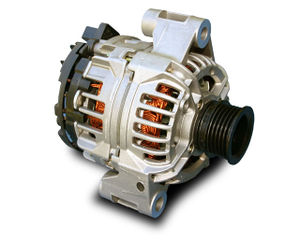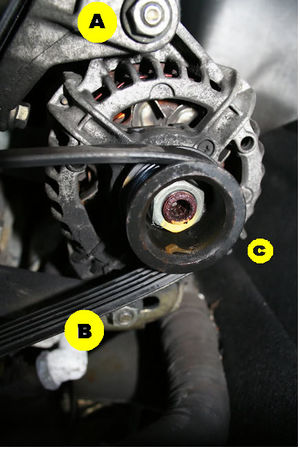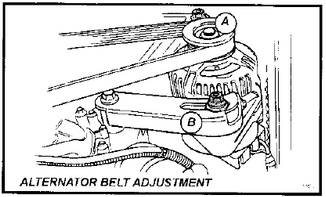Alternator
Alternator
Please add your Info, Just click EDIT
Alternator Problem Diagnosis
Common failures:
Regulator & Rectifier failure:
Battery lights flash on dash, headlights flash on when trying to start. When checking the voltage across the battery terminals readings are usually less then 12v, or can be open circuit and go high voltage 18v. This can have a detrimental affect on the battery - boils the acid/fluid if too high. Easiest solution - Remove the alternator and get checked by auto electrican.
The battery warning light on dash and flashing headlights can also be caused by a flat battery. There is a clicking as the solenoid etc click over but the engine will not start.
Bearing Failure for S2 111s and other model with 4-2-1 exhaust:
Due to the additional width of the 4-2-1 pipes, failure of the rear bearing is not uncommon. The heat from the pipes cooks the grease until the bearing runs dry and very loud. Noise produced sounds like metal grinding against metal.
Please add your Info, Just click EDIT
Alternator belt
You can change the alternator belt by taking off the rear drivers side wheel and plastic inner arch mud guard. Removing the undertray will give no advantage. You will just need a good socket set.
Loosen 'A' pivot bolt and 'B' tensioner bolt, to allow the alternator to 'swing'.
'C' on the diagram is the tensioner of the belt, loosen this to remove the belt. The tensioner bolt is the 8mm bolt on the end of the arm. It slots into the end of the arm and allows the adjustment. Difficult to see when peering in, but easy enough to locate.
The MG Rover part number for a belt for the S1 is PQS100840 and costs about £10.50 including VAT.
Tension belt to the following on S2: For heater cars - one way deflection of 6-8mm under moderate finger pressure For AC cars - as previous but 9-10mm
Removal of Alternator This is same as above but in addition you need to remove the 2No. cables; one is bolted on to the rear of the alternator using a 13mm nut, the other is a clip-on connector. Before removing the nut and cables, disconnect the battery.
Please add your Info, Just click EDIT
Alternator Heat Protection
Heat-shield fabrics claim to reflect up to 90% of the heat radiated by the exhaust and can function at temperatures unto 2000 degrees Fahrenheit.
The potential downside is that the critical components are also thermally insulated from the inside and could therefore suffer from internally generated heat, ie too much protection could make matter worse.
http://www.eliseparts.com/shop/index.php?main_page=product_info&products_id=289
http://www.elise-shop.com/index.php?main_page=product_info&products_id=80
Material can be bought here :-
http://www.merlinmotorsport.co.uk/advanced_search_result.php?keywords=heat
There are option to improve the standard of the existing manifold sheilding or to wrap the exhaust. Both of which may just push the heat elsewhere and cause problems further down the line.
Please add your Info, Just click EDIT
Sourcing Replacement
It is not recommended to purchase Chinese manufactured pattern replacement alternators for the Elise, such as those commonly advertised on ebay. They are not built to withstand sustained high revs and are guaranteed to fail prematurely. These include:
- Unipoint (ALT-4212)
Known good models include:
- Magneti Marelli (63321239)
- Bosch - OE part
- 02 111s BOSCH 0124225011
Alternator Re-build
Should your alternator bearing pack up and you don't want to buy a new one (£165) or exchange (£120-140) or repair (£40), then you can always fix it yourself.
Doing this may stop you from being able to exchange an alternator at a later date, if you have any worries stop now.
1. Remove the alternator from the car as described above, access can only be achieved through the wheel arch, with the drivers rear wheel removed. Good luck getting it out between the engine mount and the fuel filler pipes, stick with it!
2. Once you've got the alternator on the bench remove the 2 nuts and the 1 screw holding the plastic cover on and remove, then undo the 2 screws (a&b) holding the electrical parts on - remove sideway and slide out with the commutators attached.
http://i261.photobucket.com/albums/ii77/scropotnic/DSC01031.jpg
3. Undo the 4 long bolts, I used a screw driver with a hex shaft and drove it round with a spanner.
4. Using a sturdy flat blade screw drive prise the 2 halves of the body apart. This takes time and you have to work methodically work round from one side to another.
http://i261.photobucket.com/albums/ii77/scropotnic/DSC01030.jpg
5. Using a 2 or 3 leg puller pull the bearing off the shaft. I used a small hollow nut to protect the plastic shroud on the shaft, so that the centre of the puller pushed against metal instead of plastic.
http://i261.photobucket.com/albums/ii77/scropotnic/DSC01027.jpg
6. Measure the bearing using a vernier. Mine was 35mmOD, 17mmID by 10mm -- SKF 6003. Go here
http://simplybearings.co.uk/shop/index.php?osCsid=0791e0331c5e7319dc3c1e20c761ff50
Enter you bearing dimensions and obtain a product code. Then take that code over to ebay and see if you can find a 99p replacement! You could go for an uprated high temperature bearing but make sure the rpm rating is up to the job.
7. Refit the new bearing by either using a deep socket and drift or make a press from a jack, some wood and wedge under something heavy.
8. Align the 2 halves of the alternator and refit the 4 long bolts, tighten each one a 1/4 turn until tight. Refit the electronics in the reverse of disassemble, making sure to push the commutator back in first.
http://i261.photobucket.com/albums/ii77/scropotnic/DSC01029.jpg
9. Refit to the car, reconnect the wiring and tension the belt as above.
Please add your Info, Just click EDIT


